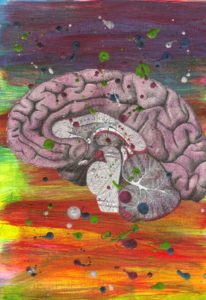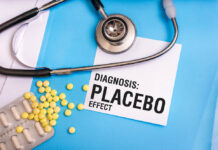In a new study published in JAMA Psychiatry, researchers investigated whether they could use EEG (electroencephalograph) technology to predict whether people would feel better after taking an antidepressant medication. They found a number of slight correlations in their EEG results, but the predictive value was almost nothing (about 5%). A somewhat more stable correlation was found for better placebo response, rather than better antidepressant response. However, most, if not all, of the results might have been due to statistical noise and might not represent true results.
The researchers write, “The effect sizes were small for most of the significant features found to moderate treatment outcome and, therefore, call for replication.”

The analysis was led by Stanford researcher Camarin E. Rolle. The team also included high-profile Harvard researcher Maurizio Fava, known for being the co-principal investigator on the STAR*D antidepressant trial. The study was a post-hoc secondary analysis of data from another trial, and was not prespecified by the researchers—which already means that the results should be interpreted with caution.
The study participants were 221 people at four different clinics. All had a depression diagnosis but were not already taking antidepressant medication. They were randomly assigned to receive either sertraline (Zoloft) or placebo. Researchers performed an EEG on each participant before treatment, and this data was connected to the participants’ score on the Hamilton Depression Rating Scale after eight weeks of treatment.
Adrienne Grzenda at UCLA, and Alik S. Widge at the University of Minnesota, wrote a commentary about the study, also published in JAMA Psychiatry. They provide important context for the results.
“A recent meta-analysis found that no published EEG biomarker met standards for clinical reliability in predicting antidepressant response, largely owing to poor methods,” they write.
But the analysis by Rolle and colleagues was superior in that it used data from four different sites, and provided a cross-validation analysis to test whether the results would be stable enough to generalize outside of the small dataset in the study.
Unfortunately, according to Grzenda and Widge, the cross-validation “suggests that many of the observed features may not be fully stable.” The results found by the researchers might be due to “overfitting.” That means that a statistical model successfully explains some of the initial data it was tested on, but doesn’t work when exposed to new data.
Another problem with the study, according to Grzenda and Widge, is that it’s impossible to precisely measure every single participant’s brain structures. Variations in the placement of electrodes for an EEG, and variations in the structure of individuals’ brains, mean that it’s impossible to compare EEG results with certainty.
Although Rolle and colleagues used their best methods to account for this, that still involves comparing individual brains to a standardized model brain, which is almost certain to be different from the actual structures of an individual’s brain. All individual physical characteristics vary to some extent between people, and there’s no real way to capture that variation in brain scan studies.
According to Grzenda and Widge, “With a limited number of scalp electrodes, an infinite number of brain patterns could produce the observed EEG, depending on one’s assumptions about the conductivity of bone, skin, and cerebrospinal fluid.”
The actual findings of the study were the following, according to Grzenda and Widge:
- Although frontal lobe regions are theorized to be involved in depression, none of those regions were correlated with improvement after treatment;
- Although connectivity within brain regions is one mechanism by which antidepressants are theorized to work, that was not correlated with improvement after treatment; and
- “None of the identified features changed during treatment, a puzzling disconnect between moderation and mechanism.”
Grzenda and Widge write that even for the moderators that were found, the effect size was small enough that “their ability to explain response variance may be quite modest.” They also write that depression is a heterogenous construct that is difficult to operationalize, as is the notion of “treatment response,” and that a study like this could “obscure” crucial differences, rather than providing helpful information.
Nonetheless, Rolle and colleagues conclude that their study might help elucidate the brain pathways by which the placebo effect works to improve mental health. “From a treatment perspective, capitalizing on the therapeutic components leading to placebo response differentially from antidepressant response could provide an alternative direction toward clinical treatment of patients with depression.”
****
Rolle, C. E., Fonzo, G. A., Wu, W., Toll, R., Jha, M. K., Cooper, C., . . . & Etkin, A. (2020). Cortical connectivity moderators of antidepressant vs placebo treatment response in major depressive disorder: Secondary analysis of a randomized clinical trial. JAMA Psychiatry. Published online January 2, 2020. doi: https://doi.org/10.1001/jamapsychiatry.2019.3867
Grzenda, A., & Widge, A. S. (2020). Electroencephalographic biomarkers for predicting antidepressant response: New methods, old questions. JAMA Psychiatry. Published online January 2, 2020. doi: https://doi.org/10.1001/jamapsychiatry.2019.3749















Thanks Peter.
Bottom line, quit throwing random chemicals at theories. Experimenting with humans is not ethical science and also we can say that experimenting with animals is not ethical.
The reports, advertising, the propaganda supporting MI, the DSM. Education about MI needs to stop since the investments in it are destructive in and of themselves, on a society and on personal level.
It is an excuse and diversion to keep us from addressing the fact that not everyone is the same and that some of us need more support than others, yet are as valuable towards the species as anyone else, or else there would not be the mystery.
It is based on the thought that every weed should be replaced with only edible plants, but sure, let us go with the thought of getting rid of instead of incorporating.
The “thinking” behind purpose, or meaning is simplistic. It is based on reliance of some conceived notion of intelligence which we have no measure to compare said intelligence of.
Yes I think folly exists. And yes I think we should abandon attempts. Some might believe that ultimately we will find utopia.
Report comment
why?
Report comment
It’s easy to see why this study proved to be raw material for cellulose insulation- the only thing the study participants had in common were depressed moods. Other than that, they were probably a heterogeneous group, depression being a syndrome instead of an actual disease.
Report comment
You mean gathering together everyone who experiences knee pain together and giving all of them the same “treatment” without any further analysis isn’t going to work? Wow, what a pessimist you are!
Though I suppose it “works” if your business is selling pain relievers.
Report comment
And if the treatment causes the kneecaps to disintegrate that’s just too bad.
They shoulda thought of that before they had knee troubles.
Report comment
The kneecaps disintegrating is merely a sad escalation of the disease process. If only we’d have gotten there in time…
Report comment
Would that be the treatment process that causes one to pile on the pounds or the treatment process that psychiatrizes Lyme symptoms (for many the first major symptom is a swollen arthritic knee). My arthritis knee was chalked up to an “athletic injury” when I was trying to run off the pounds caused by the drugs, so I got the “benefits” of “treatment” coming and going!
Report comment
that’s not paradise
Report comment
y?
Report comment
Being sarcastic. Sorry if that wasn’t obvious.
Report comment
🙂
Report comment
“Researchers Fail to Predict Antidepressant Treatment Success”
More complete and utter nonsense.
The term “antidepressant” is a euphemism for a dangerous, brain-disabling drug. What on earth could it mean for abuse by toxic chemicals to be successful? Could it be that suicides are now the leading cause of deaths in America second only to accidents? That, my friends, is the success of psychiatry.
Report comment
It’s also ridiculous to ask if “treatment” is effective for a “condition” that is utterly unmeasurable and metaphorical in nature.
Report comment
Yes.
Report comment
Well, I can testify that neither SSRIs, nor McMindfulness are effective for depression associated with Lyme infection. It’s possible an anti-inflammatory that crossed the blood brain barrier might “work” to reduce depression associated with cerebral inflammation but it still wouldn’t cure the underlying disease. “Working” in this sense is relative.
Report comment
Maybe megascorbate taken at the level just below the one that gives you the trots. It has antiviral properties at high levels.
Report comment
Lyme disease is caused by a bacteria, but you were close! 😀
Report comment
Thus we cannot experience depression, nope, not allowed, because it is abnormal and a symptom of Illness. Actually psychiatry does ALLOW depression, I forget where the cut off is. I do know there is a time limit. Only so many days of depression or grief allowed. Only so many days of non function or dysfunction allowed.
Is the ability to only do one type of job a dysfunction? It’s the secret the MI industry never shares. If not a psychiatrist or researcher in pharm, what else can you do?
Report comment
: )
Report comment
And if you don’t kill yourself, your doctor is obliged to do it for you, with medical error appropriately accounted for as the third leading cause of death.
Report comment
Not with a single lethal injection though.
A prolonged death over the course of many years via 3-10 various neuroleptics/serotonin inhibitors/tranquilizers.
That’s the only humane course to take. Motivated purely by compa$$ion. 😀
Report comment
love
Report comment
Well, if the doctor gave you a fatal OD, you wouldn’t be part of the group of depression sufferers any more, would you. Strike another successful therapeutic blow for psychiatry!
Report comment
“Death Therapy, Bob. It’s a sure cure!” From the movie, “What About Bob?”
Report comment
“Researchers Fail to Predict Responses to Random Brain Damage.”
How’s that? 🙂
Report comment
Not random. That brain damage is very much targeted. The less you think, the less you fight back.
Report comment
KS, so true. And yet if you present with no spirit or emotion, and are not on drugs, they call it apathy due to depression.
Report comment
club drug?
Report comment
That would be how I ended up on both a D2 agonist (Seroquel at night) and a D2 antagonist (Concerta in the morning).
It’s like with women “putting on their face” in the morning and washing it off at night, except now so many of us swallow our “affect” pill at the appropriate hour.
Report comment
This happened all the time with kids I knew in foster care. They’d give the kids stimulants for “ADHD” and then they got aggressive, so they’d give them an “antipsychotic” to calm them down. Raise the dopamine with one drug, decrease it with the other. Idiocy, but it was done ALL THE TIME. No science going on here!
Report comment
“We give those pesky kids fistfuls of uppers and downers. Yet their mood swings persist. Must be their defective genes,” says our educational system.
Report comment
well, we can only hope
Report comment
“Researchers Fail to Predict Antidepressant Treatment Success” I thought it was already pretty well known that psychiatrists are not fortune tellers.
Report comment
Antidepressants sold in large bottles, that mean they have a big potential.
Report comment